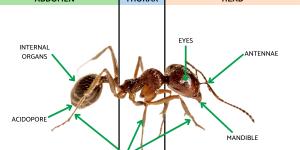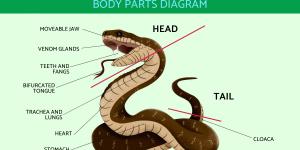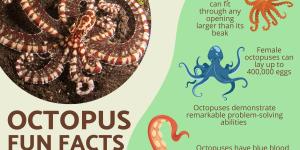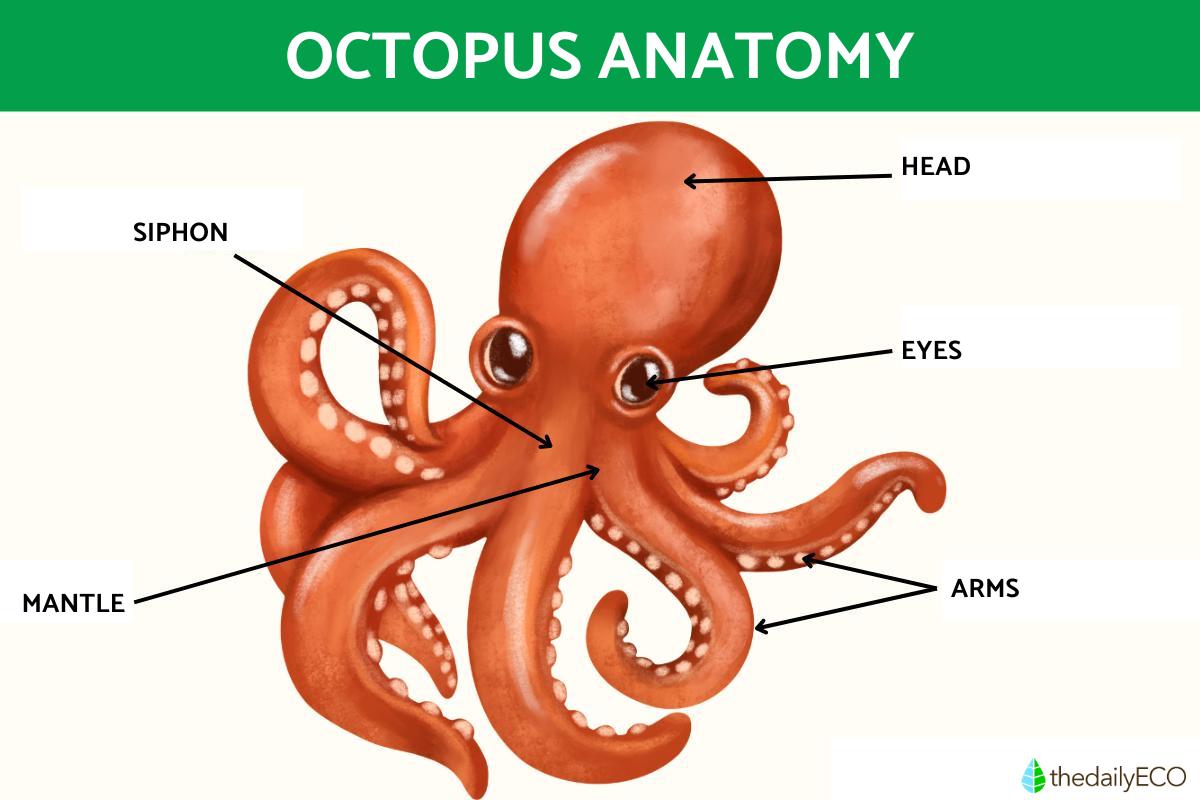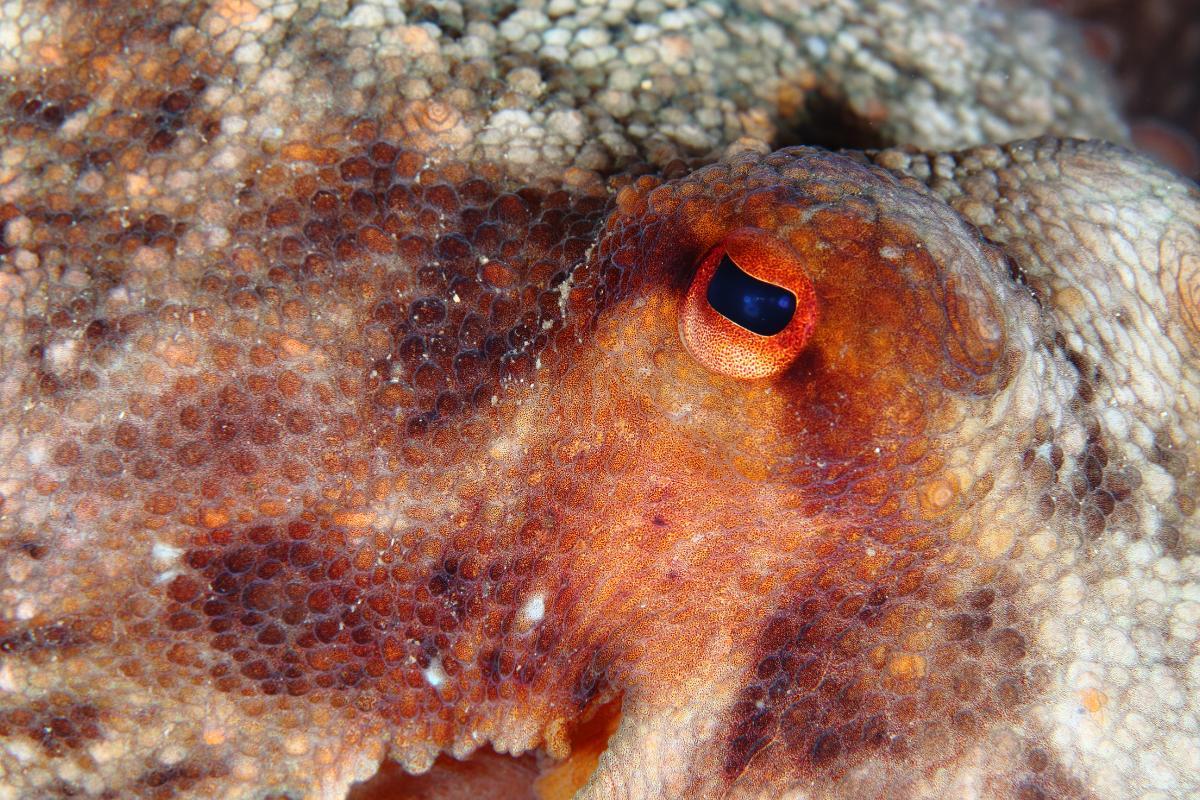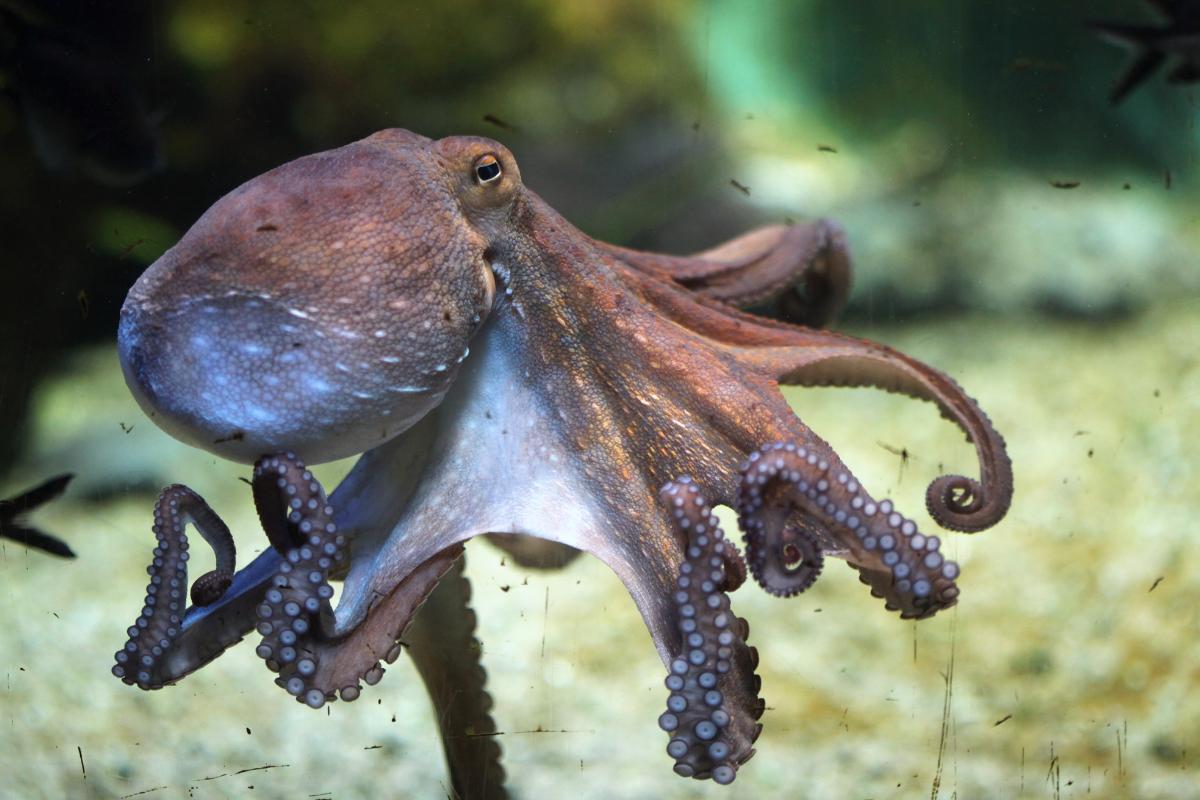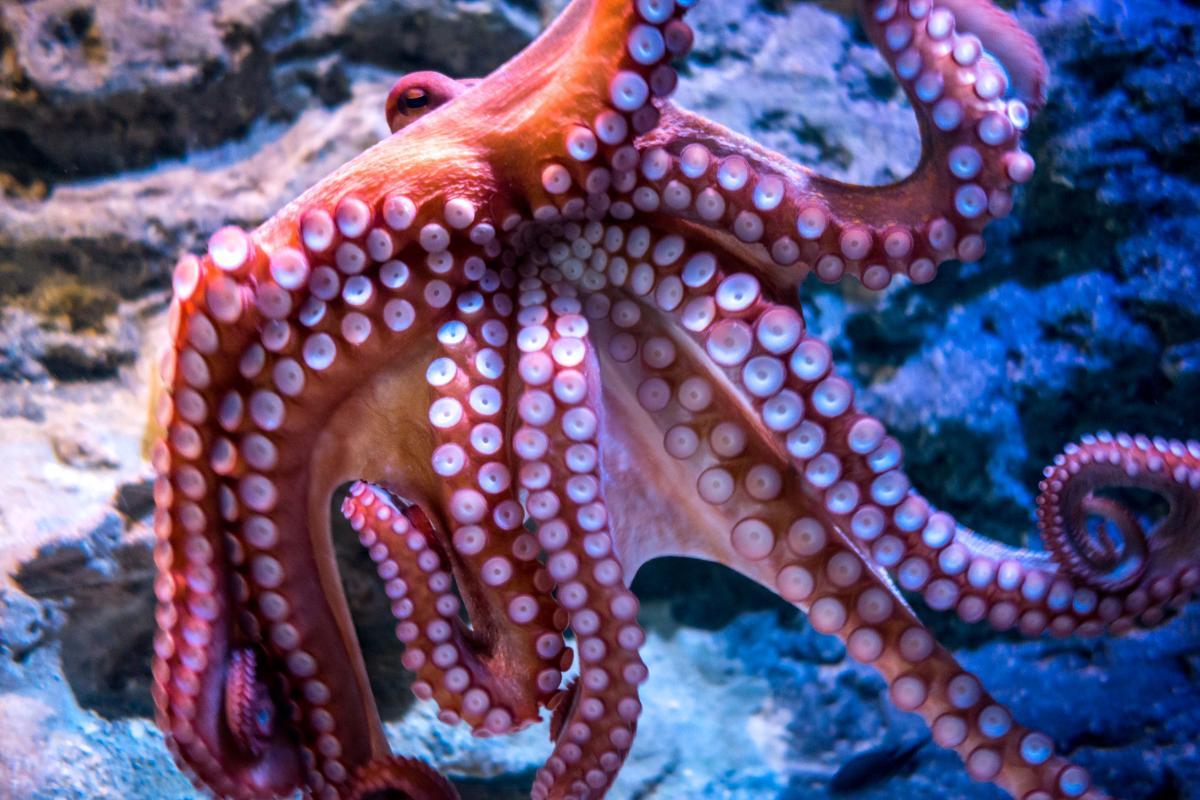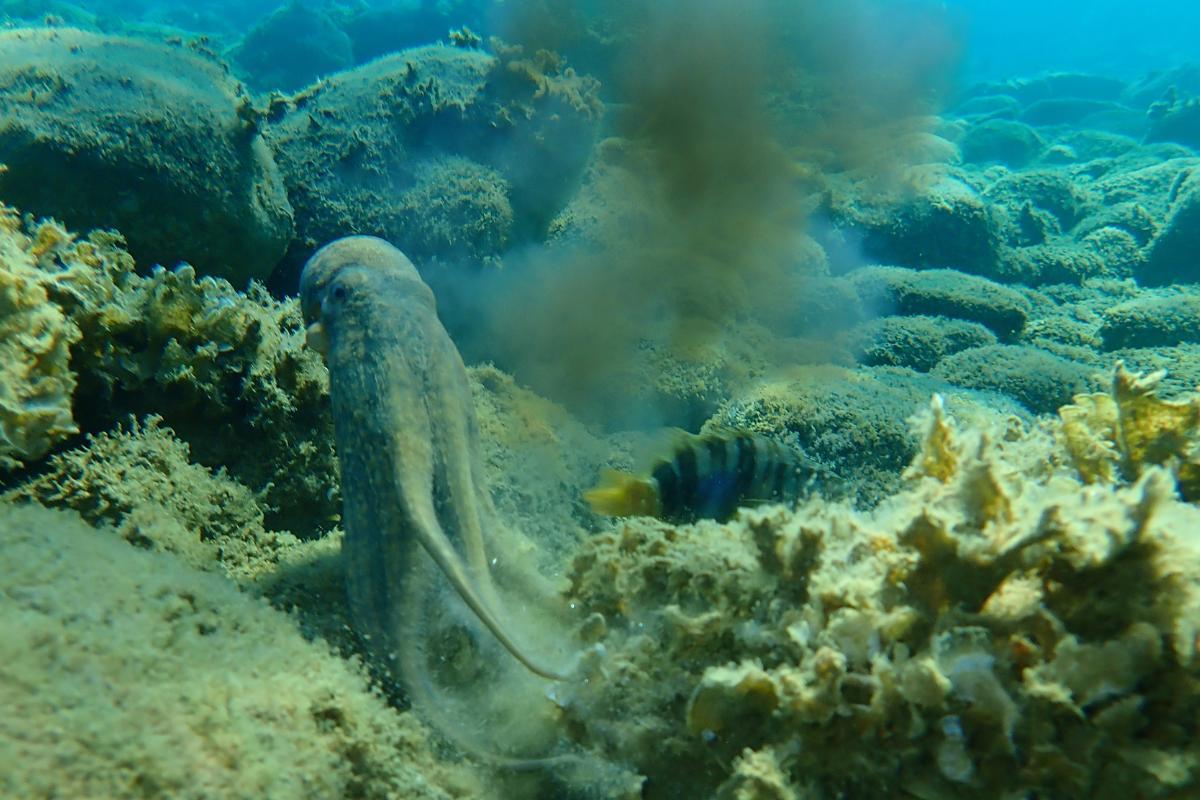Octopus Anatomy - Body Parts of an Octopus


An octopus is a type of mollusk, a category of animals that also includes snails and clams. Despite being taxonomically very similar, they share certain key differences. For example, octopuses don't have shells and snails don't have eight arms. The anatomy of an octopus is very particular. Their head makes up the largest part of their body, from which their eight arms extend. Similar to that of a bird, they have a beak which allows them to eat food. Their eyes are relatively large and they have sucker son their arms which can manipulate their environment.
We have only begun to explain the morphology of this animal, so keep reading thedailyECO to understand octopus anatomy. We provide a list of the body parts of an octopus with photos to have a better idea of their form and function.
Head
Octopuses have a well-developed head with a large brain. Not only is it large in size, but the octopus is considered one of the most intelligent animals in the world, especially since they are an invertebrate. They have the highest brain-to-body ratio of all invertebrate species.
The octopus head contains the oral cavity, two complex eyes and the siphon. Next to the brain are two special organs called statocysts. Sac-like in structure, these organs contains a mineralized mass and sensitive hairs that provide information about changes in body position associated with gravity. This allows them to better navigate their environment.
Learn more about the categorization of octopuses with our article explaining whether an octopus is a mollusk.
Oral cavity
The oral cavity of octopuses is made up of a radula and a parrot-like beak. The parrot-like beak is made up of powerful jaws that can cut and tear tissue from large prey. This food is then processed in the radula, a chitinous organ which is ribbon shaped and covered in small spikes. The radula acts like a tongue, drawing in food to pass into the mantle cavity.
Octopuses have salivary glands that secrete venom, used to paralyze their prey. However, the toxicity of this venom can vary greatly according to species. These glands also produce proteolytic enzymes that facilitate the digestive process.
Learn about other aquatic animals which produce toxins with our article on the most venomous fish species.

Eyes
Octopus eyes are some of the most complex in the animal kingdom. They are very similar to those of vertebrates such as fish. They have a cornea, pupil, lens, chambers and retina. Their pupils are slit-shaped and are located horizontally. Although they cannot detect colors, they can recognize different shapes and remember them for a considerable time.

Siphon
The siphon is a muscular funnel that connects the pallial cavity with the external environment. It can have various functions. Something particular to cephalopods such as octopuses, the siphon draws water out of the pallial cavity by propulsion, allowing their movement and escape from danger.
Mantle
The mantle is a tegumentary sheath, a protecting the octopuses organ system. These organs are very sensitive octopus body parts, so they need to be protected from trauma and under threats. It is fused to the back of the octopus's head. In both octopuses and squids, the muscular mantle is involved in the animal's locomotion.

Mantle cavity
The mantle cavity or pallial cavity is the cavity that contains the rest of the octopus' vital organs, such as the gills. In turn, the products of the digestive, excretory and reproductive systems are discharged into this cavity.
Arms
As with all mollusks, octopus anatomy includes a muscular foot. What is different to many other types of mollusk is that this foot is modified into its distinctive eight arms. These appendages have two rows of suckers which allow them to grasp or hold on to objects in their environment. They are often incorrectly referred to as tentacles, but they are not true tentacles in this sense.
Octopus arms are body parts which have tactile cells to give them an excellent sense of touch, as well as chemoreceptors to detect chemical changes in their aquatic environment. The two posterior arms are usually used as a means of locomotion, with many species using them to crawl on rocks. The other arms are used in the search for food and in holding prey.
Some octopuses that live in deep waters have their arms joined by membranes, giving them the shape of an umbrella. This particular morphology allows them to swim in a similar way to jellyfish, opening and closing their arms rhythmically.
Learn about the anatomy of the jellyfish in our related guide.

Gills
In octopuses, gas exchange takes place through body parts known as gills. These gills are located in the mantle cavity and are capable of absorbing a large percentage of oxygen. During respiration, the octopus introduces water into the mantle cavity. This water then passes through the gills and is expelled through the siphon. However, when the octopus is at rest, approximately 41% of oxygen is absorbed through the skin.
Skin
The skin is one of the most fascinating octopus body parts. It is made up of a thin outer epidermis with mucous membranes and sensory cells. It has a dermis of connective tissue made up of collagen fibers and various pigmented cells. These cells which allow rapid color changes.
In general, octopus color changes are caused by the presence of chromatophores, elastic epidermal cells containing pigments. When the chromatophores are extended, the pigment is dispersed and the animal's color pattern changes, allowing it to camouflage itself. If the animal relaxes, it returns to its original color.
Read our investigation to learn more about what are chromatophores?
Ink sac
The ink sac of cephalopods empties into the rectum, located behind the anus. This gland produces a brown or black liquid due to its high concentration of melanin. They expel it in a fast jet when they feel threatened or in danger, such as when faced with a predator. The ink sac is located very close to the siphon and this allows the octopus to expel the ink through a jet of water.

Hectocotyl arm
Octopuses are sexually dimorphic animals, although the extent of this will depend on the species. Male octopuses have a modified arm which is called the hectocotylus which acts as a copulatory organ. At the end of the hectocotylus there is a spoon-shaped depression known as the ligule. This appendage collects the spermatophores and introduces them into the pallial cavity of the female, depositing them (as in the case of specimens of the genus Octopus) inside the oviduct. In benthic octopuses the hectocotylus is usually the third arm.
While these octopus body parts are part of all octopus anatomy, there is great difference in morphology between species. Check out our article on the different types of octopus for an illustration of these differences.
If you want to read similar articles to Octopus Anatomy - Body Parts of an Octopus, we recommend you visit our Facts about animals category.
- Hickman, C. P., Roberts, L. S., & Larson, A. (2000). “Comprehensive principles of zoology”.
- Ruppert, E. E., & Barnes, R. D. (1994). Invertebrate Zoology. Sixth Edition.

